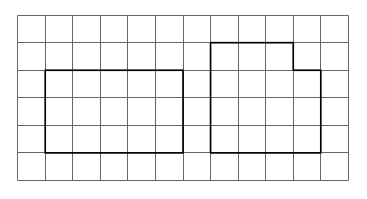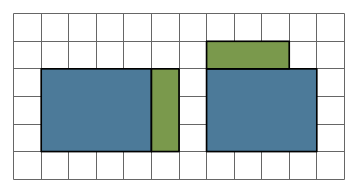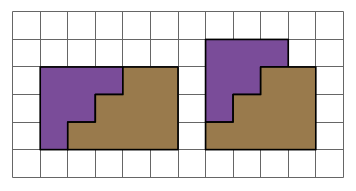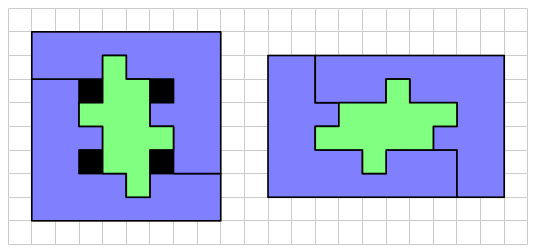Closely related to the problem of tiling the plane with polygons is that of dissecting one geometrical object into pieces that can be rearranged to form another. The classic example is the following dissection of an equilateral triangle to a square, attributed to Henry Dudeney, 1907.

Note that the pieces are exactly the same in both polygons. It’s not hard to appreciate the beauty and elegance of this “geometrical artwork.” And it’s not hard to imagine a puzzle based on this dissection — give the puzzler these four pieces with instructions to make both a triangle and a square from the same pieces.
This led me, once upon a time, to construct an Honors Geometry course centered around geometrical dissections using Greg Frederickson’s wonderful Dissections Plane & Fancy.
But even “simple” dissections — involving triangles and squares — weren’t so easy to create. For example, the pieces divide the base of the equilateral triangle into lengths and these are some of the easier calculations! I won’t say more about that here — but you can read all about this dissection and many others in Greg’s book.
and these are some of the easier calculations! I won’t say more about that here — but you can read all about this dissection and many others in Greg’s book.
So I was fascinated by geometrical dissections — but I needed a way to make the idea accessible to my students. I thought — what could you create just by experimenting with dissections on ordinary graph paper?
Well, I have been answering this question for over 15 years now. I’ll start with some introductory ideas in this post, but this is definitely not the last word on dissections!
Let’s begin with the following puzzle. By cutting the rectangle along the grid lines, how many pieces are needed so you can also make the square with a corner missing? This seems like an easy puzzle to solve, as shown below.
This seems like an easy puzzle to solve, as shown below. So yes, only two pieces are necessary — but one had to be rotated. Here is the question: can this puzzle be solved with just two pieces, but with neither piece rotated?
So yes, only two pieces are necessary — but one had to be rotated. Here is the question: can this puzzle be solved with just two pieces, but with neither piece rotated?
It turns out this is possible — but a solution requires a bit more creativity. Here is one way to do it: This is a solution technique commonly used in Dissections Plane & Fancy. Why bother? In the world of geometric dissections (and it is a growing universe, surely, as any internet search will show), finding a minimum number of pieces is the primary objective. But of all solutions with this minimum number of pieces, “nicer” solutions require rotating the fewest number of pieces. And rotating none at all is — in an aesthetic sense — “best.” It is also preferable not to turn pieces over, although sometimes this cannot be avoided for minimal solutions.
This is a solution technique commonly used in Dissections Plane & Fancy. Why bother? In the world of geometric dissections (and it is a growing universe, surely, as any internet search will show), finding a minimum number of pieces is the primary objective. But of all solutions with this minimum number of pieces, “nicer” solutions require rotating the fewest number of pieces. And rotating none at all is — in an aesthetic sense — “best.” It is also preferable not to turn pieces over, although sometimes this cannot be avoided for minimal solutions.
Another criterion for solutions might be whether they can be hinged or not, as Greg discusses extensively in Hinged Dissections: Swinging & Twisting. We won’t have time to explore this topic today.
Of course there is no reason you have to start with a rectangle, and also no reason why you need to restrict yourself to just one shape. The puzzle below shows how you can find a four-piece, rotation-invariant dissection from two smaller octagons to one larger octagon. It is important to note that the octagons here are not regular. A quick glance through Dissections Plane & Fancy will reveal that dissections involving regular polygons are generally rather difficult (as the initial triangle-to-square example amply shows).
It is important to note that the octagons here are not regular. A quick glance through Dissections Plane & Fancy will reveal that dissections involving regular polygons are generally rather difficult (as the initial triangle-to-square example amply shows).
Further, “two-to-one” dissections lend themselves nicely to a square grid, as the diagonal of a unit square has length square root of 2. Take a moment to study the octagon dissection again — paying particular attention to the side lengths — to see how this plays out. In the world of regular polygons, however, two-to-one dissections are in general quite difficult. Visit Gavin Theobald’s web page of two-to-one dissections to see some fascinating examples.
It is not hard to create dissection puzzles of your own — a pencil, eraser (!!!), and graph paper are all you need. What is difficult, however, is proving that you’ve found the fewest number of pieces. And when you have, proving that your dissection is unique. Uniqueness is virtually impossible to prove, but sometimes you can get a handle on minimality. For example, if the octagon dissection could be done in three pieces, one of the smaller octagons would have to be uncut. It’s not hard to see that there is no way of cutting the other smaller octagon into just two pieces to create the larger octagon.
What I enjoy about creating dissection puzzles is that there is not a single strategy you can use to solve them. You really need to use your imagination. Sometimes you might even surprise yourself by stumbling upon a really neat puzzle, like the one below.
Here, an 8 x 8 square with four holes (shown in black) can be dissected into three pieces to create a 6 x 10 rectangle, although one piece needs to be rotated. There is a simple elegance about this dissection which I find appealing.
Another grid which lends itself to creating dissections is a grid of equilateral triangles. We won’t go into details here, but you can get the idea with the following dissection of an irregular dodecagon to an equilateral triangle in just five pieces. (The minimal dissection with regular polygons requires eight pieces.) I’ll leave you with two puzzles to think about. Of course, you can just make up your own. If you come with anything interesting, feel free to comment!
I’ll leave you with two puzzles to think about. Of course, you can just make up your own. If you come with anything interesting, feel free to comment!
For this puzzle, my best solution is four pieces, without needing to rotate any pieces or turn any pieces over. (Black squares are holes.)
For the last puzzle, my best solution is five pieces — but I had to turn over and rotate two of the pieces.
A parting suggestion: when looking up dissections on the web, be sure to use the search words “geometrical dissections…..”
2 thoughts on “Geometrical Dissections I”